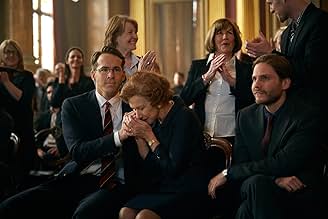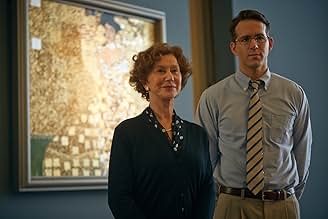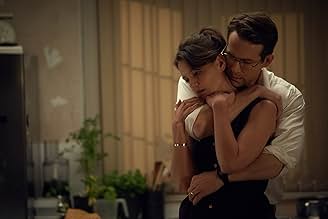IMDb-BEWERTUNG
7,3/10
65.221
IHRE BEWERTUNG
Maria Altmann, eine achtzigjährige jüdische Emigrantin, nimmt es mit der österreichischen Regierung auf, um Kunstwerke zurückzuerlangen, die ihrer Meinung nach rechtmäßig ihrer Familie gehör... Alles lesenMaria Altmann, eine achtzigjährige jüdische Emigrantin, nimmt es mit der österreichischen Regierung auf, um Kunstwerke zurückzuerlangen, die ihrer Meinung nach rechtmäßig ihrer Familie gehören.Maria Altmann, eine achtzigjährige jüdische Emigrantin, nimmt es mit der österreichischen Regierung auf, um Kunstwerke zurückzuerlangen, die ihrer Meinung nach rechtmäßig ihrer Familie gehören.
- Regie
- Drehbuch
- Hauptbesetzung
- Auszeichnungen
- 6 Nominierungen insgesamt
Empfohlene Bewertungen
'Woman in Gold' makes for a dazzling movie experience (even if at times it may leave you questioning it's authenticity). Having not been an admirer of Mirren's early screen work - she seems to have become better with age (well, for me anyway), I was taken with her portrayal of Maria Altman from start to finish (as also in 'The Queen'). Ryan Reynolds gives good support as the young Lawyer taking on a case above his station. Reynolds, whose style is somewhat reminiscent of a young Kevin Costner, plays the Randol Schoenberg part with conviction.
London born director Simon Curtis gives the proceedings an easy to watch style and with the help of documentary editor Peter Lambert, they keep the viewer engaged throughout. Curtis also gets to direct his American wife (in a guest style role) Elizabeth McGovern, who has since made England her home. First time feature screenplay writer Alexi Kaye Campbell has fashioned an interesting interpretation of the writings of Altman and Schoeenberg's own life experiences, looking back at yet another of humanity's all time low past atrocities - although as mentioned, for some, certain sections of the screenplay may not always ring true (?)
Cinematographer Ross Emery (Matrix) gets a chance to prove he's also good without the help of tons of big budget CGI. It's hard to tell who did what with the music score, credited to both Martin Phipps and Hans Zimmer but, it's pleasing in an unobtrusive manor. Design Guru's, Andrew Ackland-Snow and brothers Dominic and Giles Masters (Harry Potter) with the help of others, ensure it looks good - perhaps while also getting a chance to strut their stuff without being drenched in CGI.
As a minor point, some location settings in Austria seemed a little too devoid of people to give an accurate representation, still, it's an amazing human story, both informative and entertaining. It should please most sophisticated audiences, while letting us reflect on an episode from our dark past.
London born director Simon Curtis gives the proceedings an easy to watch style and with the help of documentary editor Peter Lambert, they keep the viewer engaged throughout. Curtis also gets to direct his American wife (in a guest style role) Elizabeth McGovern, who has since made England her home. First time feature screenplay writer Alexi Kaye Campbell has fashioned an interesting interpretation of the writings of Altman and Schoeenberg's own life experiences, looking back at yet another of humanity's all time low past atrocities - although as mentioned, for some, certain sections of the screenplay may not always ring true (?)
Cinematographer Ross Emery (Matrix) gets a chance to prove he's also good without the help of tons of big budget CGI. It's hard to tell who did what with the music score, credited to both Martin Phipps and Hans Zimmer but, it's pleasing in an unobtrusive manor. Design Guru's, Andrew Ackland-Snow and brothers Dominic and Giles Masters (Harry Potter) with the help of others, ensure it looks good - perhaps while also getting a chance to strut their stuff without being drenched in CGI.
As a minor point, some location settings in Austria seemed a little too devoid of people to give an accurate representation, still, it's an amazing human story, both informative and entertaining. It should please most sophisticated audiences, while letting us reflect on an episode from our dark past.
The Woman in Gold is based on the true story about a woman, Maria Altmann (Helen Mirren), and her lawyer, Randol Schoenberg (Ryan Reynolds), as they attempt to reclaim ownership of an extremely valuable painting (along with a few more) form the Austrian government nearly fifty years after it was stolen by the Nazis. This film has three distinct parts that intertwine through the duration of the show. First, there is a family dynamic that focuses on the emotional stress of the current situation on everyone's personal lives. There is a strong connection between Randol and Maria that grows over time and is given time to grow in these segments. Second, there are flashbacks that dive deeper into Maria's past and emphasize the importance of the artwork as well as explore parallels between the past and the present. Finally there is the trial itself, which is where the action of the conflict lies. This is the least important, yet still necessary part of the story. The percentage of time given to these segments would be around 40/40/20, respectively. While you might be surprised how much of the story takes place in the past, it really does drive the plot. There are many white-knuckle scenes and heart wrenching moments that really add to the film. The past is just as important as the present in this movie, and that is exactly what the film is trying to say. Helen Mirren, as always, was amazing in this film. She was subtle and drove many of the scenes that required raw emotion. Ryan Reynolds was also very good and his role in this film might have been his best performance (from what I have seen). Actually, all of the actors did a fantastic job here. Everyone was on there A-Game and gave it everything they had. There was great chemistry between Mirren and Reynolds which made their characters' connection even more compelling. Reynolds was able to subtly change his character as the case slowly changed his motivations. While, yes, there are a few clichéd scenes that were put in there for emotional levity and drama, but they don't really take much away, if anything. This was an excellent film and I highly recommend it.
Greetings again from the darkness. The responsibility of the filmmaker when the project is "based on a true story" is elevated when the story has significant historical relevance and blends such elements as art, identity, justice and international law. Add to those the quest of a remarkable woman whose family was ripped apart by Nazi insurgents, and more than a history lesson, it becomes a poignant personal story.
Helen Mirren portrays Maria Altmann, the woman who emigrated to the United States by fleeing her Austrian homeland during World War II, and leaving behind her beloved family and all possessions. After the death of her sister, Ms. Altmann becomes aware of the family artwork stolen by the Nazi's during the invasion. This is not just any artwork, but multiple pieces from famed Austrian artist Gustav Klimt including "Portrait of Adele Bloch-Bauer". See, Adele was Maria's aunt, and the stunning piece (with gold leaf accents) has become "the Mona Lisa of Austria", while hanging for decades in the state gallery.
The story revolves around Maria's partnering with family friend and upstart attorney Randol Schoenberg (Ryan Reynolds) to take on the nation of Austria and reclaim the (extremely valuable) artwork that was seized illegally so many years ago. They are aided in their mission by an Austrian journalist (played by Daniel Bruhl) who is fighting his own demons. The seven-plus year legal saga is condensed for the big screen and we follow Maria and Randol as they meet with the Austrian art reclamation committee, a federal judge (played by the director's wife Elizabeth McGovern), the U.S. Supreme Court (Jonathan Pryce as Chief Justice), and finally a mediation committee back in Austria. But this is not really a courtroom drama it's a personal quest for justice and search for identity. What role does family roots and history play in determining who we are today? It's the age old question of past vs. present, only this is seen through the eyes of a woman who has survived what most of us can only imagine.
Director Simon Curtis (My Week with Marilyn) uses startling flashbacks (with Tatiana Maslany as the younger Maria) to provide glimpses of Maria's childhood through her marriage and subsequent escape. We get to know her family, including some scenes featuring Aunt Adele (Antje Traue), and Maria's father and uncle (Henry Goodman, Allan Corduner). We understand this family's place in society and just how dramatically they were impacted by the Nazi takeover.
Helen Mirren delivers yet another exceptional performance and manages to pull off the snappy lines without an ounce of schmaltz, while also capturing the emotional turmoil Ms. Altmann endures. Director Curtis and writer Alexi Kaye Campbell round off some of the rough edges and inject enough humor to prevent this from being the gut-wrenching process it probably was in real life. This approach makes the film, the story and the characters more relatable for most movie goers and it's quite an enjoyable look at a fascinating woman and a pretty remarkable underdog story.
Helen Mirren portrays Maria Altmann, the woman who emigrated to the United States by fleeing her Austrian homeland during World War II, and leaving behind her beloved family and all possessions. After the death of her sister, Ms. Altmann becomes aware of the family artwork stolen by the Nazi's during the invasion. This is not just any artwork, but multiple pieces from famed Austrian artist Gustav Klimt including "Portrait of Adele Bloch-Bauer". See, Adele was Maria's aunt, and the stunning piece (with gold leaf accents) has become "the Mona Lisa of Austria", while hanging for decades in the state gallery.
The story revolves around Maria's partnering with family friend and upstart attorney Randol Schoenberg (Ryan Reynolds) to take on the nation of Austria and reclaim the (extremely valuable) artwork that was seized illegally so many years ago. They are aided in their mission by an Austrian journalist (played by Daniel Bruhl) who is fighting his own demons. The seven-plus year legal saga is condensed for the big screen and we follow Maria and Randol as they meet with the Austrian art reclamation committee, a federal judge (played by the director's wife Elizabeth McGovern), the U.S. Supreme Court (Jonathan Pryce as Chief Justice), and finally a mediation committee back in Austria. But this is not really a courtroom drama it's a personal quest for justice and search for identity. What role does family roots and history play in determining who we are today? It's the age old question of past vs. present, only this is seen through the eyes of a woman who has survived what most of us can only imagine.
Director Simon Curtis (My Week with Marilyn) uses startling flashbacks (with Tatiana Maslany as the younger Maria) to provide glimpses of Maria's childhood through her marriage and subsequent escape. We get to know her family, including some scenes featuring Aunt Adele (Antje Traue), and Maria's father and uncle (Henry Goodman, Allan Corduner). We understand this family's place in society and just how dramatically they were impacted by the Nazi takeover.
Helen Mirren delivers yet another exceptional performance and manages to pull off the snappy lines without an ounce of schmaltz, while also capturing the emotional turmoil Ms. Altmann endures. Director Curtis and writer Alexi Kaye Campbell round off some of the rough edges and inject enough humor to prevent this from being the gut-wrenching process it probably was in real life. This approach makes the film, the story and the characters more relatable for most movie goers and it's quite an enjoyable look at a fascinating woman and a pretty remarkable underdog story.
The lady in question is Adele Bloch-Bauer who was the subject of a magnificent painting, deploying lots of gold, by the Austrian artist Gustav Klimt. Following the Anschuss of 1938 when Germany took over Austria, this painting was one of many, many artefacts seized by the Nazis from Jewish families in occupied Europe.
The film tells the story - a little fictionalised - of Adele's niece Maria Altmann who escaped from Vienna to live in California and, during the 1980s as an octogenarian, pursued an audacious claim to take back this painting and other Klimt works from the Austrian Government. Helen Mirren is brilliant as Altmann in another distinguished performance in a sparkling career during which she has played everything from "The Queen" to an assassin (RED"), while Ryan Reynolds is surprisingly good as her lawyer Randy Schoenberg in a role a million miles from "Green Lantern" or "Deadpool".
There's a lot going on in this film: legal battles over the art work with some classic courtroom scenes, flashbacks (in sepia colours) to Altmann's earlier life in 1930s Vienna, and an evolving relationship between the irascible Altmann and the idealistic Schoenberg, both descendants of famous Austrians. This is not the kind of film that was ever going to be a major box office draw but it is certainly worth a home viewing.
The film tells the story - a little fictionalised - of Adele's niece Maria Altmann who escaped from Vienna to live in California and, during the 1980s as an octogenarian, pursued an audacious claim to take back this painting and other Klimt works from the Austrian Government. Helen Mirren is brilliant as Altmann in another distinguished performance in a sparkling career during which she has played everything from "The Queen" to an assassin (RED"), while Ryan Reynolds is surprisingly good as her lawyer Randy Schoenberg in a role a million miles from "Green Lantern" or "Deadpool".
There's a lot going on in this film: legal battles over the art work with some classic courtroom scenes, flashbacks (in sepia colours) to Altmann's earlier life in 1930s Vienna, and an evolving relationship between the irascible Altmann and the idealistic Schoenberg, both descendants of famous Austrians. This is not the kind of film that was ever going to be a major box office draw but it is certainly worth a home viewing.
just saw WOMAN IN GOLD and i must be of an entirely different demographic than some other reviewers, but i enjoyed it mightily. The audience obviously did also, as there was laughter and applause at various spots. The acting is wonderful and the story quite straightforward but done with both heart and a sense of humor. there is excellent use of flashback and lovely shots of Vienna. Angelenos will get a kick out of some of the recognizable LA landmarks. I have no idea of what the requested ten lines means, whether it is sentences or actual lines. It's a lovely movie. Not sophisticated but informative, entertaining and thought provoking with excellent acting from both the principals and supporting actors.
Wusstest du schon
- WissenswertesOprah Winfrey was, for ten years, the owner of Gustav Klimt's second-most-famous portrait of the subject of the painting unofficially known as "Woman in Gold." The second most famous Klimt portrait of Bloch-Bauer was officially titled "Adele Bloch-Bauer ll." Winfrey reportedly bought the painting anonymously in 2006, when Christie's sold it at auction for $87.9 million, during the same auction session when the subject of this film was sold, along with four other Klimt paintings owned by Maria Altmann's family. In 2016, Winfrey sold the 54"x54" painting, "Adele Bloch-Bauer II," to a Chinese collector for $150 million.
- PatzerWhen Randy Schoenberg is before the Supreme Court, he is shown being asked a convoluted question by Chief Justice William Rehnquist, whereupon Schoenberg admits he doesn't understand it. That question was actually posed by Justice David Souter. The reaction from the other justices, who also didn't understand the question, was accurately depicted.
- Zitate
Randol Schoenberg: It's hard to believe Hitler once applied to be an art student here.
Maria Altmann: I wish they'd have accepted him.
- VerbindungenEdited into The Spoils (2024)
Top-Auswahl
Melde dich zum Bewerten an und greife auf die Watchlist für personalisierte Empfehlungen zu.
- How long is Woman in Gold?Powered by Alexa
Details
- Erscheinungsdatum
- Herkunftsländer
- Offizielle Standorte
- Sprachen
- Auch bekannt als
- La dama de oro
- Drehorte
- Produktionsfirmen
- Weitere beteiligte Unternehmen bei IMDbPro anzeigen
Box Office
- Budget
- 11.000.000 $ (geschätzt)
- Bruttoertrag in den USA und Kanada
- 33.307.793 $
- Eröffnungswochenende in den USA und in Kanada
- 2.091.551 $
- 5. Apr. 2015
- Weltweiter Bruttoertrag
- 61.619.773 $
- Laufzeit
- 1 Std. 49 Min.(109 min)
- Farbe
- Sound-Mix
- Seitenverhältnis
- 2.35 : 1
Zu dieser Seite beitragen
Bearbeitung vorschlagen oder fehlenden Inhalt hinzufügen









































